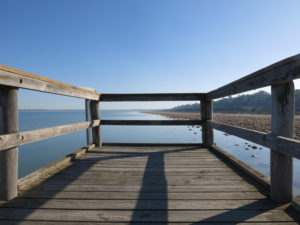
Boardwalk is an active protagonist in our visits to the thrombolites. More than just a structure which allows human access and some measure of protection to thrombolites and their ecologies, it is also a place for nonhuman perching, preening, hunting, nesting and web anchoring. Boardwalk frames children’s views and is present in photographs they take (but rarely in their drawings). Handrails, uprights and shadows (the weathering of sun-Boardwalk-child) are regular participants in children’s photos, but children (and their parents) also peer through the boards.
Boardwalk’s design offers uninterrupted vistas only to adults and is ignored as an active part of the ecology. Looking back through our own researcher photos, the boardwalk is rarely used as a framing device or a feature to add interest to a sunset shot. In fact, we have actively cropped it from most images. However, looking at the photographs that Rebecca (6 years old) took, many include parts of Boardwalk-the visual point-of-view of the child whose views are framed by Boardwalk’s timbers.
And another thing…
The presence of Boardwalk in Rebecca’s photos has caused us to wonder whether the timbers were sourced from the nearby pine plantations that drink from the same underground water sources that feed the lake? What impact might pine plantations have on thrombolites?
And although Boardwalk enables human access to the thrombolites, what are the implications for the thrombolites of Boardwalk?







